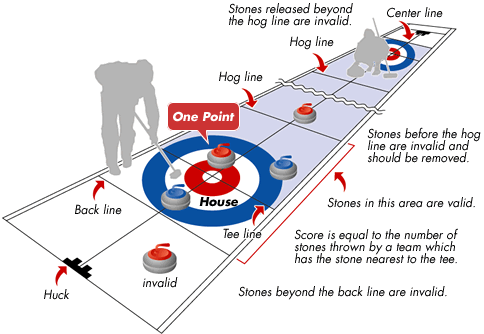Let’s Sweep the Ice!
The Winter Olympics are here, and that can only mean one thing: for the next few weeks, people who don’t like to do housework and can’t really tolerate the cold will become unnaturally interested in a sport which involves sweeping while standing on ice. Curling is back, and all is right with the world.
And while you will hopefully watch it, you probably have no idea what’s going on.
So, let’s fix that. Here’s everything you need to know to be the curling expert in your school, at work or at your next dinner party.
(Before we get there, though: If you’ve never seen a curling match, here are four-plus minutes of highlights from the finals of the men’s competition at the 2010 Olympics.)
The game features two teams of four people each, armed with brooms, shoes with gliding soles, and special granite stones which themselves have handles. The teams take to a narrow ice rink called a “sheet,” and each takes a turn launching a stone toward a target, called the “house.” The other three teammates take their brooms and furiously sweep away, hoping to make the stone do their bidding. After each team has alternated launching their eight stones (two per curler), that part of the match — called an “end” — ends. Whichever team has a stone closer to the center of the house, called the “button,” scores points during that “end,” and gets one point per stone closer to the button than the opponent’s closest stone (so long as the stones are in the house). The image below, from the Port Arthur Curling Club in Ontario, Canada, may help:

(In the above, the red team scores one point.)
Sliding rocks on ice seems like a strange thing to do, and to some degree it is — but then again, so is sticking planks of wood on one’s feet and sliding at super-high speeds down a snow-covered mountain. But people have been doing it for centuries. The first evidence of curling dates back to 1511, based on the discovery of a curling stone with that date engraved. It remained popular through the 1800s and into the early 20th century, and at times, wooden “stones” were even used. In 1998, it became an Olympic sport.
The not-so-obvious physics of the sport make it much more difficult — and much less straight-forward — than it appears. First, the ice isn’t Zamboni-ed clean like you’d see before a hockey match or a figure skating competition. In fact, the opposite is true. Before a curling match, the sheet is sprayed with water which is then given time to form little bumps called “pebble;” Wikipedia describes the ice surface as resembling the texture of an orange peel. The bottom of the curling stone is slightly concave, meaning that only a thin ring on the base of the stone comes in contacted with the pebbled ice. When these two not-quite-smooth surfaces interact, the stone beings to curl — basically, curve — and can therefore move at unexpected angles and around other stones. Experienced curlers can get a good feel for the conditions and, to a meaningful degree, control the spin of the stones.
The brooms? There’s a bit of debate around what’s going on there. In 2010, a physicist at the University of Northern British Columbia named Mark Shegelski spoke with Scientific American about the popular theories around the issue. He noted that most everyone agrees that, by sweeping in front of the stone, the broomsmen and broomswomen are reducing the friction between the stone and the ice surface, allowing the stone to move forward more quickly than it would otherwise. The issue, though, is why this happens. Most likely, sweepers aren’t knocking pebbles loose, clearing the way for the stone to enter the house. Rather, they’re warming the ice sheet up and, in the process, creating a thin liquid-ish layer between the stone’s contact ring and the surface, thereby allowing it to maintain more momentum. The sweepers, Shegelski believes, aren’t cleaning the ice — they’re melting it.
But not everything involving curling can be easily explained. Take, for example, the Russian team’s pants for the current Games — they’re well beyond explanation.
Bonus Fact: There have been eight curling events at the Olympics — four men’s, four women’s — since the sport joined the ranks of official competitions in 1998. (A mixed doubles event was considered for the 2010 Games but ultimately rejected.) Canada has taken a medal in all eight competitions — three golds, three silvers, and two bronzes.
From the Archives: Faster than a Speeding Bullet: How the speed of sound causes problems for Olympic organizers.
Related: A miniature curling stone. It’s too small to curl with and is intended to be a desk ornament.
